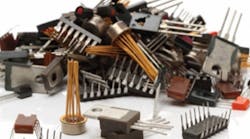Supply Chain Collaboration Yields Counterfeit Mitigation
Risk management strategies along today's semiconductor and electronics supply chain should address the ever-present issue of counterfeit, substandard, and fraudulent parts. The issue of counterfeit parts and the dangers posed by them are well discussed, as are the various means that such parts enter the supply chain. To meaningfully combat the counterfeit threat, though, requires an understanding beyond the awareness of their existence and typical loci in the chain. Successful mitigation necessitates an understanding that disruptive events and real sourcing problems arise and cannot be solved by the dictum of sole-supplier purchasing. We also need to be aware that how "counterfeit" is defined is equally important in designing successful mitigation strategies.
The real supply chain is one in which sourcing problems arise, such as unforeseen disasters, excessive lead times, end-of-life (EOL) events, or last-time-buy (LTB) run-outs. Unfortunately, the answer to addressing counterfeit threats in the semiconductor and electronics supply chain is not as simple as choosing to purchase from original component manufacturers (OCMs) or their franchised distributors (FDs), because that is simply not always possible. The global supply chain is not a closed loop. It is more of an organic, fluctuating network in which disruptive events occur and require secondary strategic solutions that bring along additional risk mitigation requirements.
When these sources cannot meet delivery requirements—often due to excessive lead times, part obsolescence, or last time buy run-outs—an independent distributor (ID) is used. When ordering through an ID, risk mitigation should be a top priority—particularly for counterfeit, quality, and reliability issues. The reason for the added risk mitigation is that IDs can run the gamut from a low tech, single person company with no checks and balances to highly sophisticated and multi-national organizations. It is critical to qualify and select them with the utmost scrutiny. In response, successful counterfeit mitigation strategies are rooted in leading industry standards for quality management and the corresponding processes and procedures, such as the International Standards Organization (ISO) ISO 9001, ISO 14001, ISO 17025; Components Technology Institute's Counterfeit Components Avoidance Procedures (CCAP-101); Certified (QC) inspectors (for example, CCCI-102, IDEA-ICE-3000, or equivalent); ANSI ESD S20.20; AS 5553 and AS 9120-A (for aerospace industries).
Robust Strategies and Collaboration
The implementation of counterfeit mitigation, therefore, should attend to the variables that support real progress for businesses by improving processes to ensure quality along the global semiconductor supply chain. National and international regulations are key to the process, and deterrents based on punishments are necessary; unfortunately, criminals are not deterred by the threat of being caught alone, given that their motivation lies in opportunism and unethical and illegal gains. That is not to say that rooting out counterfeit product is not at the forefront of successful counterfeit mitigation strategies; it is especially when you consider the significant investments in sophisticated detection laboratories and quality engineers at leading independent distributors. Detecting counterfeit, substandard, and fraudulent parts is an essential component of true quality management programs, but it is also just part of the solution matrix—and therein lies the secret to countering sophisticated counterfeiters in the global supply chain.
Transparency and collaboration are vital to rooting out non-conforming parts and shoring up vulnerabilities that are inherent to all real-world supply chains. The degree to which proactive supply chain collaboration and qualification is shared by suppliers and purchasers is linked to the success of the counterfeit mitigation strategies. In this case study, we present anti-counterfeiting expertise and strategies implemented at leading, global companies along the semiconductor and electronics supply chain that directly address the constantly evolving counterfeit threat.
On the electronics product manufacturing side, counterfeit mitigation strategies need to be differentiated based on supplier types, whether product is being sourced through OCM or franchised distributor or through the independent distributor channel. Successful risk mitigation, from disruption as well as counterfeit product, comes from having appropriately differentiated and robust strategies to manage the various types of supply chain risk and from having implemented internally collaborative models for qualifying vendors in terms of personnel, facilities and processes. The end-result is over-arching quality assurance that permeates across departments and functions guided by an inter-departmental supplier management team (SMT).
From the supplier's perspective, quality management and counterfeit mitigation are core components of business processes. Leading independent distributors have long implemented industry standards for supply chain risk management and quality management systems. A litmus test for identifying leading independent distributors is verifying (1) the importance and integration of customer/vendor collaboration as part of an active quality framework; (2) the codification of quality metrics for uniform operations and procedures (O&P) implementations; and (3) the level of investment in sophisticated laboratory tools, procedures, and quality engineer (re-)training recognized by the latest industry accreditation and certifications.
Sourcing Strategies at the Front Line of Defense
On any given day, an end-product manufacturer, such as Rockwell Automation, may need to place a purchase order for one or many component parts to meet production requirements. These orders are typically placed with the OCM or a franchised distributor. However, there are also real business events that occur, and when these sources cannot meet delivery requirements—often due to excessive lead times, part obsolescence, or LTB run-outs—an independent distributor is used. When ordering through an independent distributor, risk mitigation should be a top priority (particularly for counterfeit, quality, and reliability issues). Rockwell Automation has found the organizations with most success are those that have solid, standardized internal processes and procedures with a dedicated SMT with a determined set of supplier qualification criteria and evaluation methods. The SMT should be responsible for screening, auditing, approving, and reporting the results of supplier evaluations so that all purchasing is directly tied into these continuously updated reports. Suppliers deemed as high risk would then be classified as prohibited sources.
The criteria the SMT uses to qualify suppliers are different depending on the type of supplier—that is, franchised distributors and OCMs versus independent distributors. All suppliers should be evaluated, and contingency plans should be in place for supply disruptions, EOL, and LTB events. SMT qualification criteria centers around specific, detailed requirements that the SMT uses to evaluate and rate suppliers for the company. Such criteria may include the following:
- Quality Management System/certifications/safety
- Process and personnel requirements
- Facilities/equipment
- Supply chain management
- Quality control/quality assurance processes and procedures/documentation control
- Performance metrics/continual improvement plans
- Contingency plans
- Risk
Within the end-product manufacturer's organization, representatives from various disciplines (such as component engineering/engineering, supplier quality assurance (QA), and strategic sourcing/purchasing) should be engaged in qualifying the independent distributor. Furthermore, independent distributors should go through the same approval and stratification process that any other supplier would go through, but with additional criteria due to the variation in the quality of independent distributors. In the case of independents, the above list should only be a starting point—that is, the core criteria to which the following qualifications may be added:
-
Certifications:
- ISO 9001
- CCAP-101 (Counterfeit Components Avoidance Procedures)
- Certified (QC) inspectors (for example, IDEA-ICE-3000, CCCI-102, or its equivalent)
- ANSI ESD S20.20
- AS 5553 and AS 9120-A (for aerospace industries)
- ISO 14001 (environmental standard)
- ISO 17025 (testing and calibration standard)
-
Affiliations, Memberships and Bid Code:
- ERAI (Electronic Resellers Association International)
- GIDEP (Government-Industry Data Exchange Program)
- CAGE codes (Commercial & Gov't Entity) vs. EPLS (Excluded Parties List System)
-
Facilities and specialized laboratory equipment for counterfeiting detection:
- Controlled environment stockroom
- Quarantine capabilities
- Industry certified and/or accredited testing laboratory
- Industry recognized processes and procedures
- Process qualifications
- Documented and acceptable Counterfeit Avoidance Management Program (CAMP)
-
Lab and testing equipment should include:
- Real Time X-Ray
- Various high magnification optical microscopes
- Chemical Decapsulation Equipment
- Heated chemical blacktop/re-mark testing (Dynasolve)
- XRF
- Trained or certified personnel for counterfeit detection
- Source control and traceability
- Strict supplier qualification and rating system
- Documentation and reporting procedures
- Certificates of Compliance/Checklist
- On-site audit
Successful results of SMT implementation at Rockwell Automation include:
- Improved supplier screening for quality, ability to meet technical needs, on-time delivery, price, productivity improvements, ease of business conduct
- Supplier Quality Control Processes & Procedures
- Earlier supplier selection and collaboration
- Assuring new parts go to preferred suppliers/approved suppliers/preferred technologies
- Mitigating risks from natural disasters, obsolete parts, labor strikes, supplier bankruptcy, political unrest, and so forth
As a global, end-product manufacturer, Rockwell Automation has found that SMTs are a highly-valuable means for mitigating counterfeit risk well before the actual product would ever arrive on the premises.
Drill down into suppliers' quality framework
Just as important to your successful counterfeit mitigation strategies is the need to ensure that your distributor is equally dedicated to quality supplier screening for its vendors. As we drill down into the supply chain, counterfeit mitigation succeeds when distributors along the supply chain have stringent quality metrics, sourcing qualifications, and codifications that meet and exceed industry standards.
Leading independent distributors are global, professional businesses with long-standing reputations and quality track records that can (and should) be audited, reviewed, and examined. Their quality metrics and compliance should demand of their sources the same levels of review, scrutiny, careful qualification, and track-record evaluations. Smith & Associates offers an example of best-in-class practices by a global independent distributor. For more than 30 years, Smith has been a global independent distributor and has continuously refined and integrated its quality framework, which exemplifies the four key elements on which any best practices supplier quality program is built:
- Know your sources.
- Certify inspection and testing processes.
- Sync customer needs with internal processes.
- Document operating procedures and incorporate them as part of the internal IT systems.
By integrating this framework enterprise-wide through codified practices, Smith & Associates ensures uniformity and reliability. With every department focused on quality and utilizing the same framework and information, Smith is able to ensure adherence to the quality assurance processes. The result is a more complete and precise approach to quality management systems (QMS) in direct support of counterfeit mitigation. The company's operational processes and vendor management systems are documented and tied together under a "Quality Umbrella.” This unifies goals and practices by:
- Having all departments focused on one goal;
- Requiring individual responsibility for quality in all tasks; and
- Ensuring all processes and procedures are followed.
The end result is that operations and procedures (O&P) delivers quality.
In counterfeit mitigation—particularly at the independent distributor level where vendor screening should be closely monitored—it is critical that a company is able to codify and qualify vendors continuously. Sourcing along the global electronics supply chain requires both vigilance and deep market and vendor knowledge to ensure that counterfeit products are kept out of the supply chain. However, being vigilant is simply not enough. Integrated tools unifying each department at the independent distributor ensures adherence to regulations and customer requirements. For Smith, Workschain™, a customized and unique IT tool, integrates the operations, finance, sales, and purchasing departments through an internally transparent platform. Data such as visual images, part information, laboratory testing, vendor rating history, logistics, traceability, checklists, requirements, and sophisticated testing data collected in accordance with its numerous industry certifications, such as ISO 17025, are available as required by each of the users.
Because of the fluidity of the global electronics supply chain, distributors such as Smith & Associates have a continuous vendor screening and vendor management system alongside its visual screening and sophisticated, in-house laboratory testing:
-
Vendor Screening (continuous)
- AVL application process codified
- AVL annual reviews with pre-defined metrics
-
Vendor Management
- On-site audits
- Continuous record evaluations
- History of sourcing relationships
- Quality Management & Quality Control operations
-
Detailed visual screening by trained inspectors consists of:
- Microscopic inspection
- Digital measurement
- Full image collection
- Archive
-
In-house lab testing:
- In-house, state-of-the-art laboratory (see below for some critical items)
- Verify product authenticity
- Follow accredited QMS processes & procedures
- Full documentation & reporting
-
In-house component testing lab equipment (not limited to):
- C-SAM Scanning Acoustic Microscope (ultrasonic non-destructive microscopy)
- Counterfeit IC Detector
- Jet Etch Decapsulation System
- INspexX130 X-Ray Machines (Real Time – non-destructive)
- Luxo & Keyence Microscopes (optical microscopes)
- Dynasolve Chemical Testing
- Hawk I X-Ray Florescence (non-destructive)
- Solderability Test System
- Functionality Testing
A fully equipped laboratory with properly trained quality engineers is required to fulfill specific quality requirements and have the ability to conduct in-house testing. Should a suspect, fraudulent, or counterfeit part be identified, it is equally important to have quarantine and safe handling practices in place that follow industry best practices. Among the processes and procedures that should be formalized when handling suspect or counterfeit parts, are the following:
- Segregate and quarantine substandard and suspect product.
- Initiate customer notification and resolution process.
- Follow formal return policy.
- Determine disposition and/or safe destruction of part (shredding and environmentally compliant disposal).
- Follow reporting protocols.
- Review vendor per AVL and vendor screening protocols.
- Workschain™ update alert, the entire enterprise at once.
Though some have argued that sophisticated component testing for substandard and counterfeit parts simply add to the costs of buyers and therefore may put them at a competitive disadvantage, this is not the view held by leading independent distributors. To NOT test and to NOT have state-of-the-art, certified, and accredited testing is an untenable business event. The risks are extremely high for those without full laboratory testing in-house or not having thorough quality management and supplier screening procedures and processes in place. The introduction of counterfeit product to the supply chain and/or to customers is an unthinkable situation for independent distributors—one that would both cause irrevocable damage to the independent distributor’s reputation and put clients and their products at risk.
Collaboration and transparency: Successful anti-counterfeit strategies
In the end, as with any strategy, counterfeit mitigation is only as good as the team's ability to execute it appropriately, thoroughly, and effectively and then to ensure that all purchasing strictly adheres to the continuously updated vendor rating system in place. At the heart of counterfeiting is opportunism. Occluding this opportunism is possible through diligent collaboration and the implementation of proactive, meticulous, and targeted anti-counterfeiting procedures that should include both collaboration within and among the departments in accordance with the quality framework and the use of specialized lab equipment operated by qualified personnel. Information sharing and transparency are critical both within and across organizations so that if counterfeit or substandard product is found, the proper reporting is performed, the suspect product and sources are permanently removed from the supply chain, reports are filed, and any non-conforming parts are properly destroyed.








